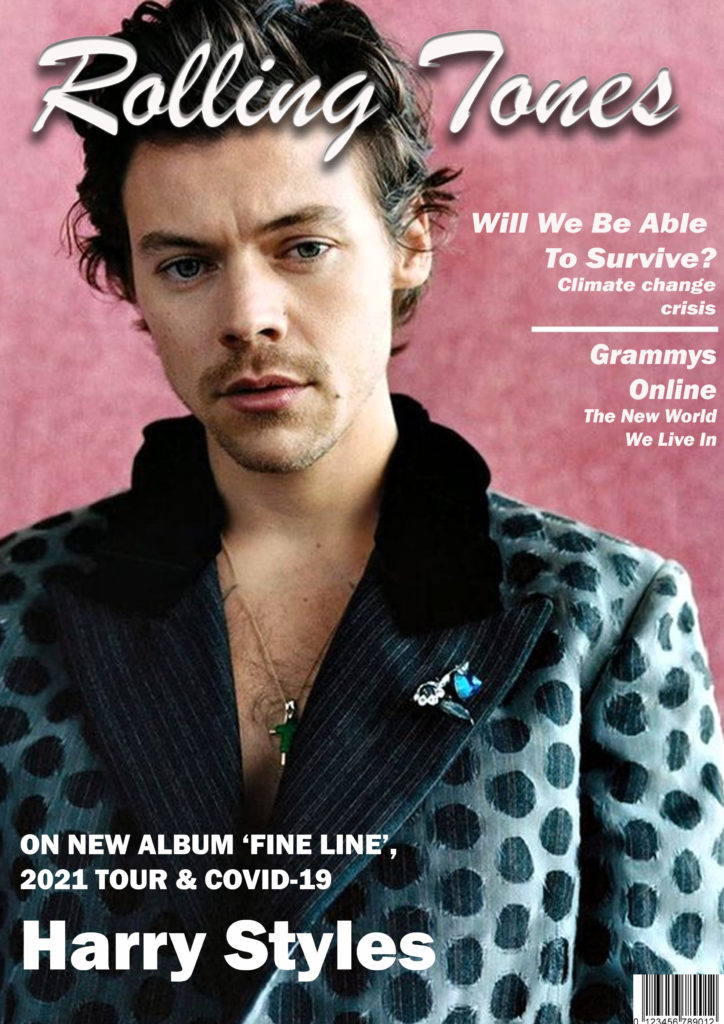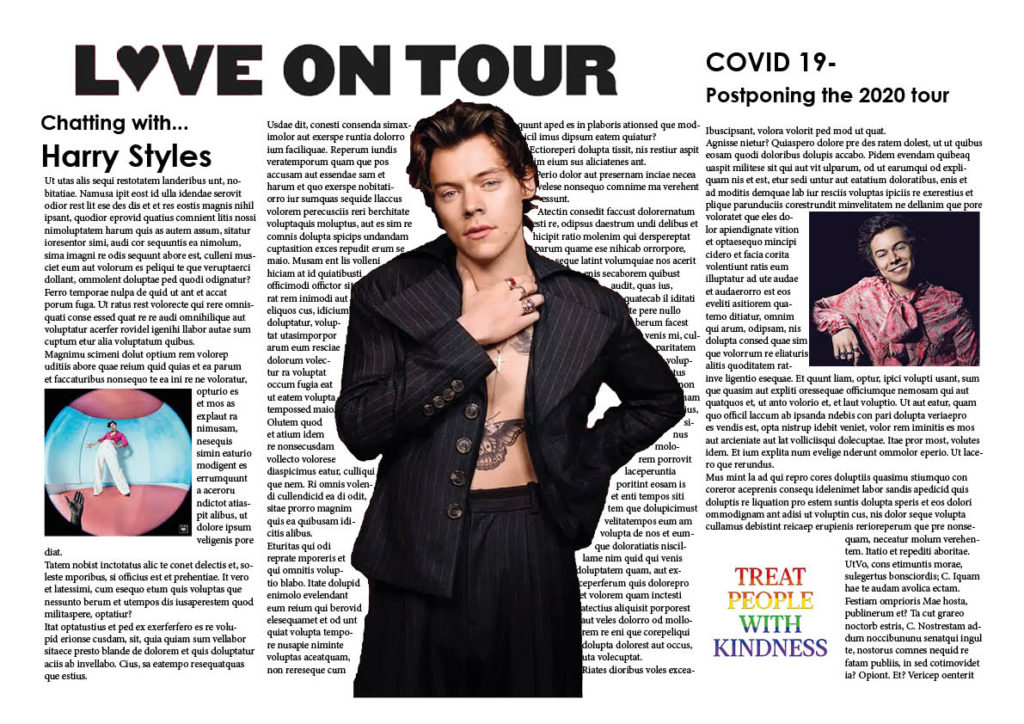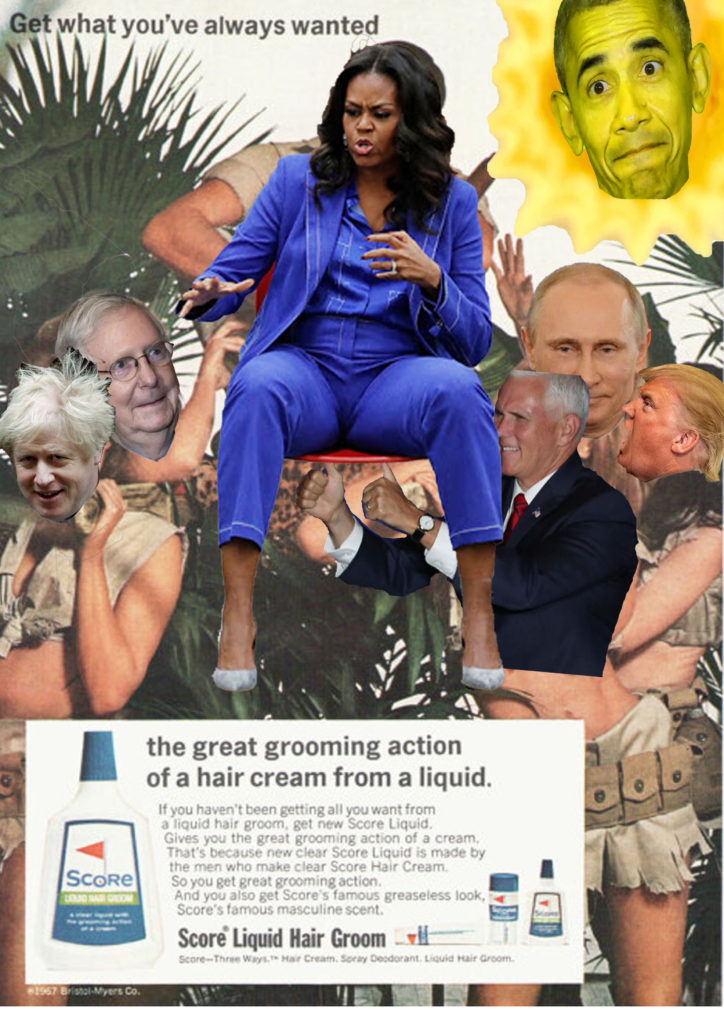
Score parody (art)


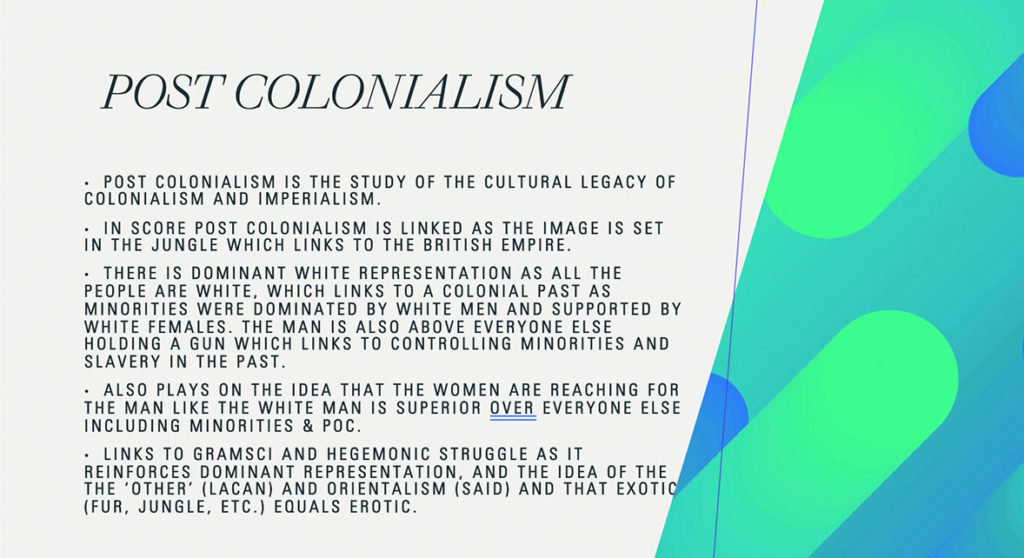
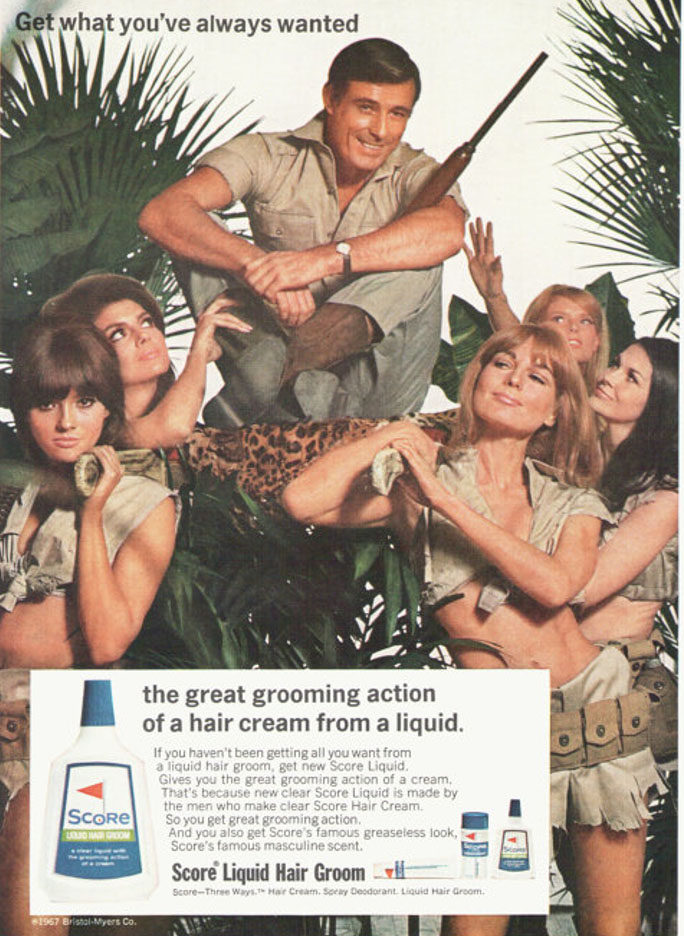
Score uses advertising to market their product to there consumers, they do this through using media language to encourage consumers to buy their products.
Media Language
Mise-en-scene- the man holding the gun represents masculinity and power, the fact he sitting above everyone shows he has dominance and is in control of the situation. The fact he is surrounded by girls in very little clothing suggests that he gained all the girls through this magical hair cream.
The image is set in the jungle- links to post colonialism- white man has power over minorities, empire.
Slogane- “get what you have always wanted” this suggest through using the hair cream you can get all greatest desires.
1967- during this time this advert would be very appealing to men, as it fits into the style and aesthetics of the 60s, with the hair and makeup the girls were wearing, women were also regularly objectified and seen more and as an object that could be won, which would tie into the idea that men could win women with this hair cream.
Representation
This advert was designed before the 2nd wave of feminism and the sexualisation was widely acceptable which is why and advert like this would have been popular.
This advert feeds into the dominant ideology that women are only useful as an object of a mans desires. This plays on sexist stereotypes that men should be masculine and that women should obey them.
Laura Mulvey- Male Gaze, this advert plays into the idea that media is tailored to the male gaze (having pretty girls in little clothing), score uses this to advertise there hair cream to men by gaining their attention through women.
B.F. Skinner-
Operant conditioning. eg positive reinforcement, negative reinforcement & punishment. “The fiction of free will”– determinism, no free will, result of environmental and biological factors.
Harold Lasswell– hypodermic model
He was involved in ww1, he explored propaganda techniques ww1 in book (1927), “brew up a subtle poison, which could be injected into the veins”
Hypodermic model– direct injection= passive audience.
Propaganda is overtly political and manipulative, and the processes of persuasion is invisible at first glace.
Liner model of communication– who (sender), says what (message), channel (media), to whom (receiver), with what effect (feedback)
.

Adapted by Shannon and Weaver in 1949, to become Transmission model of Communication, including elements like noise, error, encoding and feedback.
The age of surveillance capitalism– Zuboff
Emerging behavior control technology (mobile phones) used to stimulate certain behaviors. “technology had begun to develop new methods of behavior control capable of altering not just an individual’s actions but its very personality and manner of thinking.”
Cambridge Analytica
Alexander Nix- harvesting data and using it to tailor ads. Influenced Brexit, and Trump 2016 campaign by targeting ads on Facebook to influence voting.
Two Step Flow of Communication (active consumption)
Paul Lazarfeld– developed the two step flow of communication this in 1948, messages are not directly injected to into the audience but in fact they go through a opinion leaders first, who interpret media messages first and then relay them back to a bigger audience. Audiences are active not passive
.

Uses and Gratifications (active selection)
This approach doesn’t categories audiences as passive or active more focuses on the decision making process of the audience themselves. Research began with Denis McQuail and Jay Blumler, in 1969 as they looked into the 1964 UK Election. In the early 1970’s they were joined by Elihu Katz, Joseph Brown, Michael Gurevitch and Hadassah Haas.
There researched showed that individual audience members were more active and as a result a key part of the processes of selection, interpretation and feedback.
Audiences used media to gain gratifications. Which could be categorised into;
Or categorised as: diversion, personal relationships, personal identity and surveillance
This links into Maslow’s Heirarchy of Needs, which shows social and psychological needs of the audience which is why they use the media in order to gain these.
.

Cultivation Theory – effects over time
George Gerbner– worked on a large-scale, positivist, in-depth, longitudinal study into the effects of television, which started in 1975- developed cultivation theory
‘television cultivates from infancy the very predispositions and preferences that used to be acquired from other primary sources‘ (Gerbner et al 1986)- tv shapes the way individuals see & think. ‘watching television doesn’t cause a particular behavior, but instead watching television over time adds up to our perception of the world around us‘ (cited in West, 2014).
Noam Chomsky- manufacturing consent
Louis Althusser- IDEOLOGICAL STATE APPRATUSES (ISA’s)
The Theory of Preferred Reading
Stuart Hall- critical theory that looked to analyse mass media communication and popular culture as a way of both uncovering the invidious work of the State and Big Business.
He provided three main distinct positions that could be occupied by individual viewers;
Clay Shirky: The End of Audience
A theory that through new media technology there is no longer an audience but instead only individuals.
‘the more ideas there are in circulation, the more ideas there are for any individual to disagree with.’
Chomsky
Daily mail advertises products which are ideal for their audience to consume eg a cruise advert within paper, as they have an an older audience this product reaches to them as generally older retired people go on cruses. This ties into one of the 5 filters of manufacturing consent, the role of advertising.

Another one of the 5 filters of manufacturing consent is seen as the common enemy. This can be seen in this front cover as they are seen to be targeting the left wing and rallying their readers against those who disagree with May’s actions, this is because the newspaper supports the conservatives.
The I also uses advertising to reach to their readers, in this front cover you can see a large advert for a holiday destination. this shows that the newspaper isn’t trying to hid there ads as you can clearly see a big advertisement as soon as you see the paper, it shows that they are very clearly interested in feeding into consumer culture.
Habermas
Both newspapers share differing opinions into the public sphere, for example the daily mail supports the right wing so puts out news which supports these views therefore influencing their audience where as the I takes a more centralist view therefore nether sides with the left or ring wing which means there news is more impartial and is a more reliable source when influencing consumers opinions in the public sphere.
Althussar
Althussar’s ideas of isa is that the state uses media to form peoples views of the world. This can be seen in the daily mail when Boris Johnson is presented as having done a good job with a Brexit deal, this benefits the state as it gives the public confidence in the government whereas in reality the Brexit deal that Boris Johnson got wasn’t much different to the deal Theresa May got previously. This then forms the public opinion differently to what it may have been without the positive reinforcement form the daily mail.

The I also influences peoples opinions however the newspaper is less bias as they take a centralism stance which means they don’t directly favour one side of the government unlike the daily mail which means that they aren’t as influential.
Curran
As Curran describes the media as a public watchdog, this can be seen in the I as they offer a non bias critical view into the government which allows the state to be criticised and held accountable. This can be seen in this front cover as they are seen to be criticising the tories for cutting labours funding, it is important that these issues are shared through media outlets otherwise the public would not know about the conservatives attempts to gain more power and control. The public should be informed in such matters in order to make an educated decision when voting.

Seaton
Seaton discusses the theory of public service which refers to the BBC which is a public service broadcasting institution, both the daily mail and the I are not public service institution as they are both owned by the daily mail and general trust. this means that they feed into capitalist media as the generate revenue through advertisements. The owner of these newspapers also have massive influence into what is published and therefore what influences the public opinion.
Gramsci
Gramsci holds the idea of hegemony and the hegemonic struggle that some people face. This idea of hegemonic struggle can be seen in the daily mail. In this front cover of the newspaper it is seen to be focusing on Theresa may and Nicola surgeons legs rather than their political views, this demonstrates some of the hegemonic struggles faced by women in a male dominated field such as politics, that media tabloids enhance this through articles which objectify woman in this way.

| The i | The daily mail |
| The I was founded on the 26 October 2010 | The daily mail was founded on may 4 1896 |
| Owned by the daily mail & general trust | Owned by the daily mail & general trust |
| political stance on the centre of the political spectrum (both left & right) | imperialist (right wing) |
| Both provide the news but the I focuses on politics & social inequalities. | Both provide the news but the daily mail focuses on celebrity gossip as a tabloid |
| Oliver Duff (37) is a British journalist who has been the editor of the i newspaper since June 2013. As a younger journalist he provides new content which makes the I more interesting | George Carron Greig (59), is an English journalist and editor of the Daily Mail. because the editor of the daily mail is older it may explain why their content is targeted at an older audience |
| Daily readership of 233,869 by February 2019 | Daily readership of 2.2 million |
| Aimed at “readers and lapsed readers” of all ages and commuters with limited time | lower-middle-class British women, average age of 58 |
| 38% decrease in sales from June 2019 to June 2020 | 15% decrease in sales from June 2019 to June 2020 |
| Both online & newspaper | Both online & newspaper |
| Both have a similar layout with big bold text however the I is less busy and looks more professional compared to the daily mail. The images are also smaller. | Both have a similar layout with big bold text however the daily mail is more busy and the text is more black and white compared to the I which uses red text, this makes the images stand out more on the daily mail. |
The Daily Mail is a national daily tabloid newspaper that has historical, social, cultural and political significance. The Daily Mail, launched in 1896 offers many opportunities for studying the relationship between ownership patterns, economic factors and political viewpoints.
The paper is owned by the Daily Mail and General Trust.[6] Jonathan Harmsworth, 4th Viscount Rothermere, a great-grandson of one of the original co-founders.
A survey in 2014 found the average age of its readers was 58
Daily mail bought the i for 49.4 million in 2019
t had an average daily circulation of 1,134,184 copies in February 2020. Between April 2019 and March 2020 it had an average daily readership of approximately 2.180 million
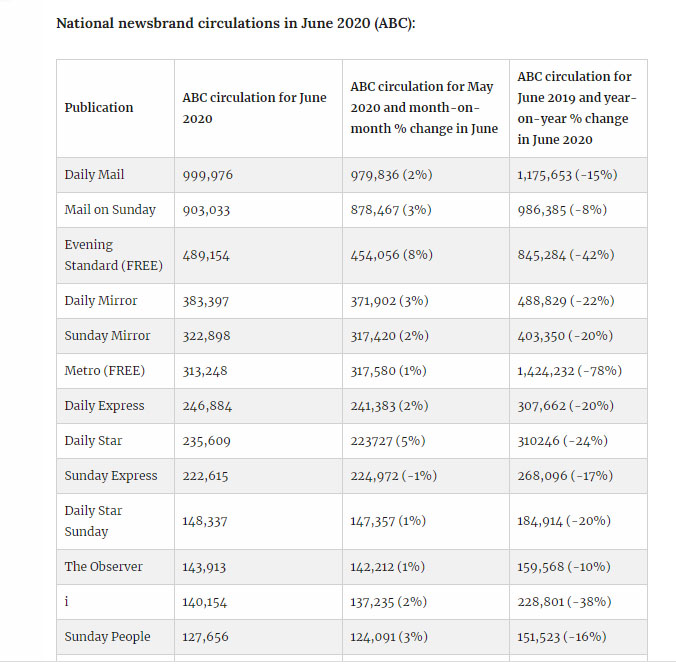
Wikipedia editors have voted to ban the Daily Mail as a source for the website in all but exceptional circumstances after deeming the news group “generally unreliable”
The liberal theory of free press- James Curran
“the freedom to publish in the free market ensures that the press reflects a wide range of opinions and interests in society”
“the market based press is independent because it owes allegiance only to the public”
“the press is not Representative, because it is owned and controlled by the powerful”
“the standard themes of liberal theory are open to more far reaching objections that are provided by the press commissions”
Broadcasting and the theory of public service- Jean Seaton
“British broadcasting was started as a public service, and this proved as creative commercially as it was innovative culturally.”
“the BBC creating a image of its audience as ‘participants’ in the great affairs of the nation”
“broadcasting in Britain- monopoly-duopoly- always depended on an assumption of commitment to an undivided good.”
“one cause of the collapse of the principle of public service broadcasting has been the deterioration in the relationship between the state and broadcasting institutions.”

capilist media- big conglumerates, making capital
public service media- BBC, dosent make profits, reinvest money into the business, role is to inform the public
civil society media- very small independent media- parish newsletter, hospital radio, etc

Jurgen Habermas and the concept of the Public Sphere
Habermas created the idea of the public sphere that is a virtual community where people are able to spread ideas and opinions to one another which can be done through the use of media. this public sphere can be used to influence other people. He also explained how the public sphere is a direct way companies can communicate to consumers.
James Curran & Jean Seaton – the theory of the liberal free press
James Curran and Jean Seaton discussed Habermas ideas about the public sphere and how they are relevant to media today in terms of education and government. Curran also described that the media is a public watchdog which looks over the state. In Jean Seaton and James Currens book ‘power without responsibility’ they speak about the idea of liberal free press and the the ownership of the media and there influences on the media we consume.
Noam Chomsky – the 5 filters that manufacture consent
Chomsky believed that institutions controlled what their audience believed by:
Louis Althusser – interpellation & Ideological State Apparatus
This is when the state uses sources such as the media, religion and school to convey and control the people in to believing what they want. Interpellation is the process of getting a population to believe that message and a formation of that belief
Antonio Gramsci – the concept of hegemony / hegemonic struggle
A hegemonic idea is a dominant idea that most people believe and therefore the hegemony is a widely held belief that the dominant population hold. The hegemonic struggle is when a radical text challenges this hegemony and therefore is a difference of opinions when powers differ.
